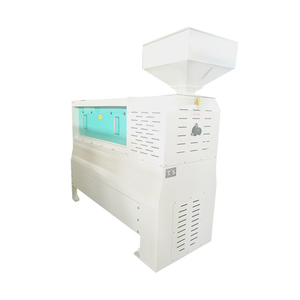-
 Encontrar enMiembros
Encontrar enMiembros Encontrar enVideos
Encontrar enVideos Encontrar enCanales
Encontrar enCanales
This website uses cookies to ensure you get the best experience on our website.
To learn more about our privacy policy haga clic aquíPreferencia de privacidad
- Etiquetas - #Rice Polisher
-
- Última actualización 21 de octubre de 2018 0 comentarios, 311 vistas, 0 likes
More from gong liang
More in Politics
Related Blogs
Archivo
The Horizontal Rice Polisher Machine
Cuerpo
Compared to the sturdy, solidly constructed vertical Rice Polisher(LIANGGONG) cone, the horizontal rice polisher machine developed by the Japanese is more compact in its construction details. Basically the machine consists of a cylindrical abrasive roll clamped on a horizontal shaft that runs at high speed (about 1000 rpm) in a cylindrical polishing chamber, which is covered with a slotted perforated sheet. A feeding screw, fixed on the horizontal shaft, feeds the rice into the free space between the abrasive roll and the slotted cylinder. A counter pressure is built up in this space by an adjustable valve fitted in the rice outlet spout of the machine. The counter pressure of this valve, which is controlled by a weight balance, controls the pressure and friction applied to the rice inside the machine. Over the full length of the cylindrical housing three rows of adjustable steel brakes are installed that can be adjusted from 0° (axial) to 90° (radial). These adjustable brakes direct the position of the rice grain inside the machine during the polishing process to obtain an optimum whitening efficiency.
For a long grain variety the position of the brakes is 0°. The rice grains are lined up in an axial direction and roll under pressure through the whitening chamber. For short grain varieties the position of the brakes is 90°. In this case the rice is lined up in a radial direction and tumbles through the pressure chamber of the machine. If long grain rice is processed in the machine at the 90° adjustment of the brakes the grain will be badly broken. The brake adjustment has a range between 0 and 90° and the correct angle of adjustment depends on the variety of rice to be processed. This remains a very critical point in the operation of this machine and requires an experienced operator. A disadvantage of this machine is that the clearance cannot be adjusted. Once the diameter of the 250-mm roll is reduced by about 6 mm it must be replaced. The rolls, which are made of grit 32 silicium carbide, cannot be recoated and new supplies from the manufacturers have to be secured continuously.
Click Rice Whitener to learn about more information.







Comentarios